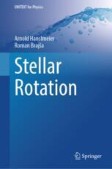Search
Search Results
-
Solar Cycle Structure and Structure of Activity Cycles at Late-Type Stars
AbstractIt is shown that a description of the solar cycle using the odd zonal harmonic of the solar magnetic field expands our capabilities in two...

-
Convective Line Shifts in the Spectra of Solar-Type Stars
AbstractThe Doppler line shifts in the spectra of the Sun and stars with effective temperatures from 4800 to 6200 K were measured and the average...

-
Study of solar neighborhood open cluster NGC 6475 and 11 possible members B-type stars
In the present paper, we performed the optical, astrometric and spectroscopic studies for the open star cluster NGC 6475 using Gaia DR3 data. Using...

-
Characteristics of Long-Term Spot Activity on Several Late-Spectral-Type Stars
AbstractWe present our analysis of many-year photometry for several dozens of chromospherically active stars that exhibit solar-type activity (from...

-
The Role of Binary Stars in Understanding the Physics and Evolution of Stars
AbstractThe diversity of close binary stars (CBSs) and the rich manifestation of their activity as a result of the interaction of stellar components...
-
Surface activity of rapidly rotating stars from simultaneous X-ray and UV observations with AstroSat
Our study focuses on analysing the coronal, transition and chromospheric activity of four rapidly rotating stars located within 50 pc in the solar...

-
Stars
The star is the most familiar and undoubtedly the most transcendental astronomical object. The word comes from the Latin stella and designates any...
-
Quark stars in the pure pseudo-Wigner phase
In this paper, we consider the scenario of a pure quark star which is completely composed of quarks in the pseudo-Wigner phase. The equation of state...

-
Herbig Stars
Herbig Ae/Be stars are young contracting stars on the radiative track in the HR diagram on their way to the main sequence. These stars provide a...

-
The s process in massive stars, a benchmark for neutron capture reaction rates
A clear definition of the contribution from the slow neutron-capture process (s process) to the solar abundances between Fe and the Sr-Zr region is a...

-
Neutron Stars
Neutron stars are highly compact astrophysical objects and therefore of utmost relevance to learn about theories of gravity. Whereas the proper...
-
Metallicity of Young Stars of the NGC 4068 Galaxy
AbstractBased on archival images from the Hubble Space Telescope, stellar photometry of the galaxy NGC 4068 was carried out. The resulting...

-
Activity of Two Young Stars of Solar Type with Planetary Systems from the Ursa Major Moving Group of Stars and the Stream Psc-Eri
High precision data from the archive of the TESS space mission are used as the basis of a study of the photometric variability of two young analogs...
-
Signatures of convection in the atmospheres of cool evolved stars
Evolved cool stars of various masses are major cosmic engines, delivering substantial mechanical and radiative feedback to the interstellar medium...

-
The formation of merging black holes with masses beyond 30 M⊙ at solar metallicity
Gravitational-wave astronomy has revealed a population of stellar-mass black holes more massive than observed previously by other means. The maximum...

-
The discovery space of ELT-ANDES. Stars and stellar populations
The ArmazoNes high Dispersion Echelle Spectrograph (ANDES) is the optical and near-infrared high-resolution echelle spectrograph envisioned for the...

-
Periodicity of Flare Frequency of Active Flare Stars Detected by Tess
Data from the TESS orbital observatory are used to study the most active flare stars indicating 100 or more flares during the period from July 2018...
-
The Digitized First Byurakan Survey Data Base. Late-Type Stars Candidates. New Confirmations. I
The Digitized First Byurakan Survey (DFBS) is the digitized version of the First Byurakan Survey (FBS, or Markarian survey). The FBS was the first...
-
Stars—Fundamentals of Their Physics
In this chapter, we provide an overview of the physics of stars and the parameters that describe them, such as mass, temperature, and density.
-
X-ray detection of astrospheres around three main-sequence stars and their mass-loss rates
Stellar winds of cool main-sequence stars are difficult to constrain observationally. One way to measure stellar mass-loss rates is to detect the...

